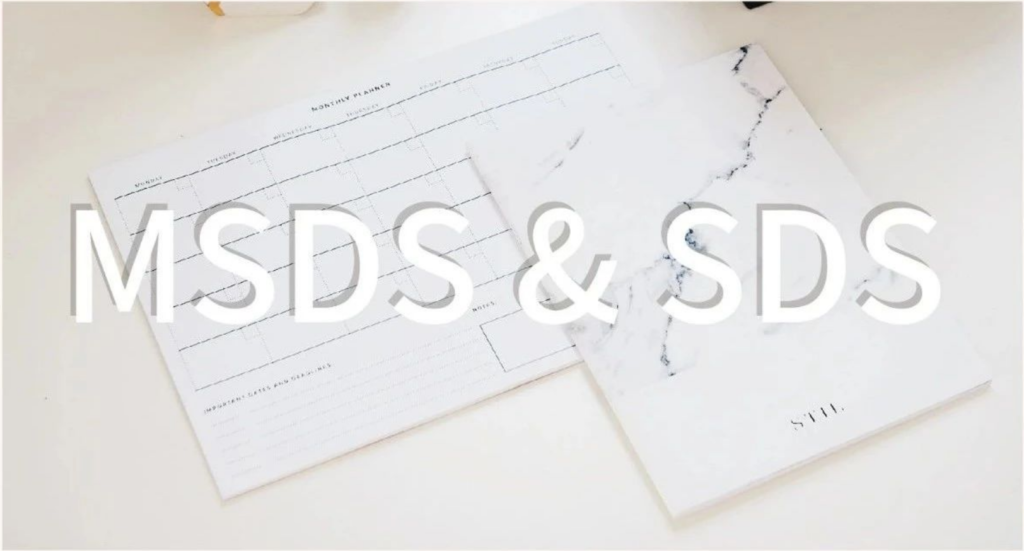Whether it’s an MSDS or an SDS, the purpose of these documents is to provide guidance on the safe handling, transport, and disposal of chemicals. These documents should ideally be prepared by the manufacturing company based on the potential hazards posed by the chemical components in their products. However, as the use of SDS becomes more widespread, and due to regional and international variations, questions have arisen. What are the differences between MSDS and SDS? How do North American MSDS and European MSDS differ? Is there an expiration date for MSDS? Can manufacturers create their MSDS? In this article, we will address these questions and provide insights.
The Connection and Distinction between SDS and MSDS
SDS stands for Safety Data Sheets, and it’s the format specified in the Globally Harmonized System of Classification and Labelling of Chemicals (GHS) and European regulations. SDS typically consists of sixteen sections, which is the format commonly used today.
On the other hand, MSDS stands for Material Safety Data Sheets. Before 2012, many countries in North America, Australia, and Asia used MSDS, which only had twelve sections. In 2012, the United States Occupational Safety and Health Administration (OSHA) aligned its requirements with GHS regulations, changing the requirement from MSDS to SDS. However, the content in sections twelve to fifteen of SDS is not strictly enforced.
From a regulatory perspective, these documents should now be referred to as SDS. Additionally, SDS requirements may vary depending on the region or country. For instance, European SDS requires the inclusion of the European Chemicals (EC) number in section three, in addition to the Chemical Abstracts Service (CAS) number. This is why distinctions between European SDS and North American SDS exist.
Is Sample Testing Required for SDS Reports?
In principle, sample testing is not required for MSDS reports. Manufacturers need to provide detailed information about the product’s composition and basic information, based on which the MSDS is assessed and prepared according to relevant standards. However, if customers wish to include product images in the report, samples are required for photography. Furthermore, if the composition of the product is unclear, testing samples may be necessary to obtain the required data.
Does an SDS Report Have an Expiration Date?
SDS reports that are internally generated by manufacturers do not have strict expiration date requirements. However, they should be updated in the following situations:
- Changes in regulations and their requirements.
- Alterations in the substances/ratios/components of the product.
- Discovery of new hazards associated with the product.
- Updates in toxicological or ecological information related to the substance.
- Special expiration date requirements from customers.
Additionally, the transportation information in section fourteen of the SDS report is related to documents like the Dangerous Goods Regulations (DGR), International Maritime Dangerous Goods (IMDG) Code, European Agreement Concerning the International Carriage of Dangerous Goods by Road (ADR), Transport of Dangerous Goods (TDG), and others. These documents are updated annually or biennially, so SDS reports need to be kept up-to-date to ensure that all referenced regulations are the most current versions. Third-party organizations often specify the validity period for SDS reports to ensure compliance.
Can Manufacturers Create Their SDS?
SDS documents are typically prepared by chemical manufacturing companies and provided as guidance to those handling their chemicals. However, the transportation industry, particularly the maritime sector, pays close attention to section fourteen of SDS reports, which contain transportation information. To ensure that the transportation information in SDS reports complies with the latest regulatory requirements, shipping companies often require that SDS reports be prepared by third-party organizations, and some may even require these reports to be certified with the China National Accreditation Service (CNAS) stamp.
In summary, while MSDS and SDS serve similar purposes, the format and requirements differ, especially between North America and Europe. The need for sample testing, the expiration of SDS reports, and the ability for manufacturers to create their SDS documents vary based on specific circumstances and regulations.

